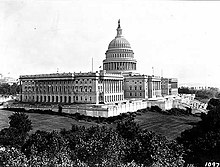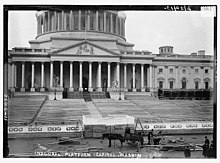63rd United States Congress
| 63rd United States Congress | |
|---|---|
62nd ← → 64th | |
 United States Capitol (1906) | |
March 4, 1913 – March 4, 1915 | |
| Members | 96 senators 435 representatives 5 non-voting delegates |
| Senate majority | Democratic |
| Senate President | Thomas R. Marshall |
| House majority | Democratic |
| House Speaker | Champ Clark |
| Sessions | |
| Special: March 4, 1913 – March 17, 1913 1st: April 7, 1913 – December 1, 1913 2nd: December 1, 1913 – October 24, 1914 3rd: December 7, 1914 – March 3, 1915 | |
The Sixty-third United States Congress was a meeting of the legislative branch of the United States federal government, composed of the United States Senate and the United States House of Representatives. It met in Washington, D.C. from March 4, 1913 to March 4, 1915, during the first two years of Woodrow Wilson's presidency. The apportionment of seats in the House of Representatives was based on the Thirteenth Census of the United States in 1910. Both chambers had a Democratic majority.
Major events

- March 4, 1913: Woodrow Wilson became President of the United States.
- March 9, 1914: The Senate adopted a rule forbidding smoking on the floor of the Senate because Senator Ben Tillman, recovering from a stroke, found the smoke irritating.
- July 28, 1914: World War I began in Europe
- August 15, 1914: The Panama Canal was inaugurated
- August 19, 1914: President Woodrow Wilson declared strict U.S. neutrality
- November 1914: United States House of Representatives elections, 1914 and United States Senate elections, 1914
- November 16, 1914: Federal Reserve Bank opened
Major legislation
- May 27, 1913: Kern Resolution
- July 9, 1913: Saboth Act
- July 15, 1913: Newlands Labor Act
- October 3, 1913: Revenue Act of 1913 (Federal Income Tax), including Underwood Tariff
- October 22, 1913: Urgent Deficiencies Act
- December 19, 1913: Raker Act
- December 23, 1913: Federal Reserve Act, ch. 6, 38 Stat. 251, 12 U.S.C. § 221, et seq.
- May 8, 1914: Smith-Lever Act, ch. 79, 38 Stat. 372, 7 U.S.C. § 341
- June 24, 1914: Cutter Service Act
- June 30, 1914: Cooperative Funds Act
- July 17, 1914: Agricultural Entry Act
- July 18, 1914: Aviation Service Act
- July 21, 1914: Borland Amendment
- August 13, 1914: Smith-Hayden Act
- August 15, 1914: Sponge Act
- August 18, 1914: Cotton Futures Act of 1914
- August 18, 1914: Foreign Ship Registry Act
- August 22, 1914: Glacier National Park Act of 1914
- September 2, 1914: War Risk Insurance Act (Rayburn Act)
- September 26, 1914: Federal Trade Commission Act, ch. 311, 38 Stat. 717, 15 U.S.C. § 41
- October 2, 1914: River and Harbors Act of 1914
- October 15, 1914: Clayton Antitrust Act, ch. 323, 38 Stat. 730, 15 U.S.C. § 12, et seq.
- October 22, 1914: Emergency Internal Revenue Tax Act
- December 17, 1914: Harrison Narcotics Tax Act
- January 28, 1915: Coast Guard Act
- March 4, 1915: Merchant Marine Act of 1915
- March 4, 1915: River and Harbors Act of 1915
- March 4, 1915: Standard Barrel Act For Fruits, Vegetables, and Dry Commodities
- March 4, 1915: Federal Boiler Inspection Act
- March 4, 1915: Uniform Bill of Lading Act
- March 4, 1915: Occupancy Permits Act
Constitutional amendments
- April 8, 1913: 17th Amendment was ratified, creating a popularly elected U.S. Senate instead of the original process of appointment by state legislatures.
Party summary

Senate
| Party (shading shows control) |
Total | Vacant | |||
|---|---|---|---|---|---|
| Democratic (D) |
Progressive (P) | Republican (R) |
|||
| End of previous congress | 47 | 0 | 48 | 95 | 1 |
| Begin | 49 | 1 | 42 | 92 | 4 |
| End | 53 | 96 | 0 | ||
| Final voting share | 55.2% | 1.0% | 43.8% | ||
| Beginning of next congress | 56 | 0 | 40 | 96 | 0 |
House of Representatives
- Democratic (D): 291 (majority)
- Republican (R): 134
- Progressive (P): 9
- Independent (I): 1
TOTAL members: 435
Leadership
Senate
- President of the Senate: Thomas R. Marshall
- President pro tempore: James P. Clarke
- Majority Whip: J. Hamilton Lewis (D)
- Minority Whip: James Wadsworth, Jr. (R) until March 4; Charles Curtis (R) starting March 4
House of Representatives
- Speaker: Champ Clark (D)
Majority (Democratic) leadership
Minority (Republican) leadership
Members
Senate
Most Senators were elected by the state legislatures every two years, with one-third beginning new six-year terms with each Congress. A few senators were elected directly by the residents of the state. Preceding the names in the list below are Senate class numbers, which indicate the cycle of their election. Senior senators are listed first.
House of Representatives
Employees
Senate
- Secretary:
- Charles G. Bennett of New York
- James M. Baker of South Carolina, elected March 13, 1913.
- Sergeant at Arms:
- E. Livingston Cornelius of Maryland, elected December 10, 1912
- Charles P. Higgins of Indiana, elected March 13, 1913
- Chaplain: F.J. Prettyman, Methodist, elected March 13, 1913.
House of Representatives
- Clerk: South Trimble of Kentucky, elected April 7, 1913.
- Sergeant at Arms: Robert B. Gordon of Ohio, elected April 7, 1913.
- Doorkeeper: Joseph J. Sinnott of Virginia, elected April 7, 1913.
- Postmaster: William M. Dunbar of Georgia, elected April 7, 1913.
- Clerk at the Speaker’s Table: Bennett C. Clark
- Chaplain: Henry N. Couden, Universalist, elected April 7, 1913.
References
- Gould, Lewis L. (2005). The Most Exclusive Club. Cambridge, MA: Perseus Books Group. ISBN 0-465-02778-4.
{{cite book}}: Cite has empty unknown parameter:|coauthors=(help) - Remini, Robert V. (2006). The House. New York: HarperCollins Publishers, Inc. ISBN 0-06-088434-7.
{{cite book}}: Cite has empty unknown parameter:|coauthors=(help) - U.S. Congress (2005). "Biographical Directory of the U.S. Congress". Archived from the original on 1 June 2006. Retrieved June 1, 2006.
{{cite web}}: Cite has empty unknown parameter:|coauthors=(help); Unknown parameter|deadurl=ignored (|url-status=suggested) (help) - U.S. House of Representatives (2006). "Congressional History". Archived from the original on 1 June 2006. Retrieved June 1, 2006.
{{cite web}}: Cite has empty unknown parameter:|coauthors=(help); Unknown parameter|deadurl=ignored (|url-status=suggested) (help) [dead link] - U.S. Senate (2006). "Statistics and Lists". Archived from the original on 1 June 2006. Retrieved June 1, 2006.
{{cite web}}: Cite has empty unknown parameter:|coauthors=(help); Unknown parameter|deadurl=ignored (|url-status=suggested) (help)
